Você é novo no WordPress ou está finalmente pronto para mudar do editor clássico para o editor de blocos?
O editor de blocos do WordPress é o editor padrão para escrever conteúdo e editar seu site. Ele foi introduzido em 2019 com o apelido de Gutenberg e substituiu o antigo editor clássico.
Na WPBeginner, fizemos a mudança do editor clássico para o Gutenberg logo no início. Nossos redatores já usam o editor de blocos há anos e aprendemos algumas dicas e truques valiosos ao longo do caminho.
Depois de tantos anos brincando com o editor de blocos, temos um profundo conhecimento de como usá-lo de forma eficaz.
Neste tutorial, mostraremos a você como usar o editor de blocos do WordPress e dominá-lo para criar posts e páginas de blog visualmente impressionantes.
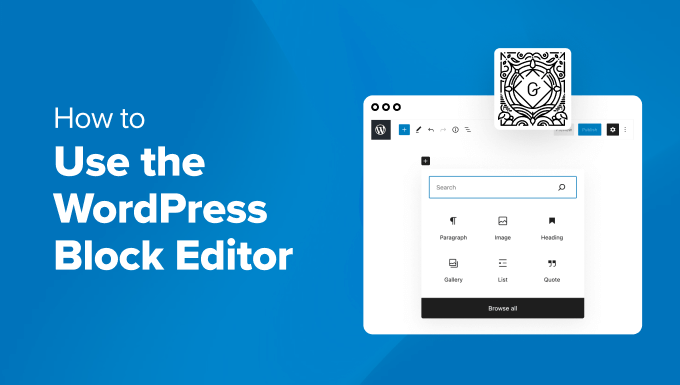
Observação: Neste artigo, estamos falando sobre o uso do editor de blocos, que foi projetado para editar seus posts e páginas. Se estiver se perguntando como editar todo o seu site com blocos, consulte nosso guia completo sobre a edição completa do site no WordPress.
Qual é a diferença entre o Block Editor (Gutenberg) e o Editor Clássico?
Antes de mergulhar no editor de blocos, vamos comparar e entender as diferenças entre o Gutenberg Block Editor e o antigo Classic Editor.
Esta é a aparência do editor clássico do WordPress:
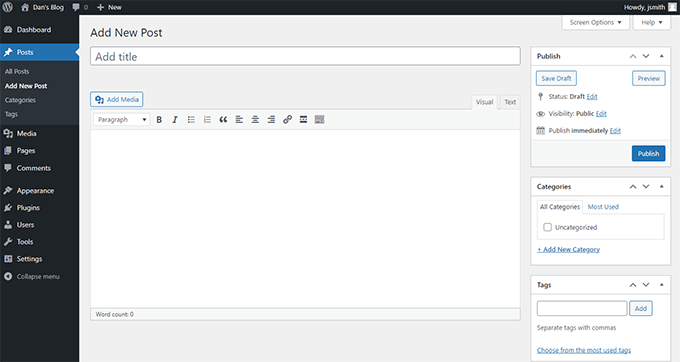
Ele tinha uma caixa de editor de texto com algumas opções básicas de formatação. Sua funcionalidade e aparência visual eram bastante limitadas.
Esta é a aparência do editor de blocos no WordPress:
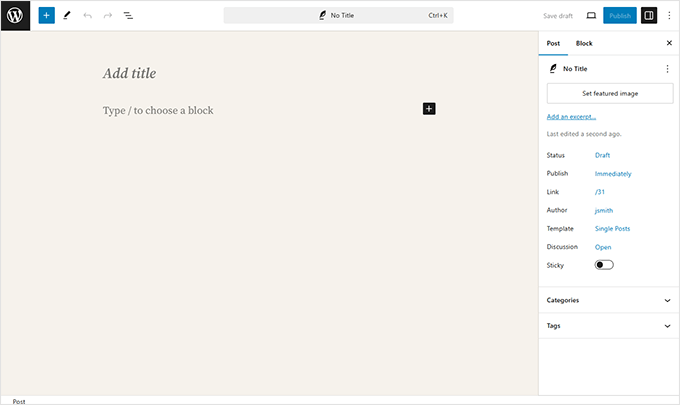
Como você pode ver, são dois editores completamente diferentes para criar conteúdo no WordPress.
O antigo editor clássico era um editor de texto com botões de formatação semelhantes aos do Microsoft Word.
O novo editor usa uma abordagem diferente chamada “Blocos” (daí o nome Block Editor).
Os blocos são elementos de conteúdo que podem ser adicionados à tela de edição para criar layouts. Cada item que você adiciona ao seu post ou página é um bloco.
Por exemplo, você pode adicionar blocos para parágrafos, imagens, vídeos, galerias, áudio, listas e muito mais. Há blocos para todos os elementos de conteúdo comuns, e outros podem ser adicionados por plug-ins do WordPress.
Como o editor de blocos do WordPress é melhor do que o editor clássico?
O editor de blocos do WordPress oferece uma maneira simples de adicionar diferentes tipos de conteúdo a seus posts e páginas.
Por exemplo, se você quisesse adicionar uma tabela ao seu conteúdo usando o editor clássico, precisaria de um plug-in de tabela separado.
Com o editor de blocos, você pode simplesmente adicionar um bloco de tabela, selecionar suas colunas e linhas e começar a adicionar conteúdo.
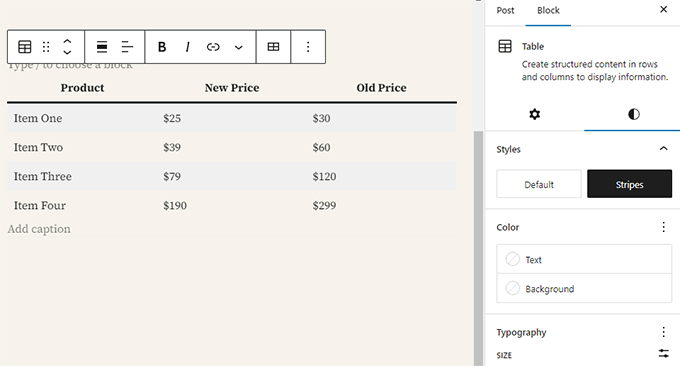
É possível mover elementos de conteúdo para cima e para baixo, editá-los como blocos individuais e criar facilmente conteúdo rico em mídia.
O mais importante é que o editor de blocos do WordPress é fácil de usar e aprender.
Isso oferece uma imensa vantagem a todos os iniciantes em WordPress que estão começando seu primeiro blog ou criando um site de negócios DIY.
Dito isso, vamos examinar como usar o editor de blocos do WordPress para criar conteúdo excelente como um profissional.
Aqui está o que abordaremos neste tutorial do Gutenberg:
- Using Gutenberg – The WordPress Block Editor
- Creating a New Blog Post or Page Using The Block Editor
- How to Add a Block in the Block Editor
- Working With Blocks in the New Editor
- Organizing Blocks in Groups and Columns
- Saving and Reusing Blocks in Gutenberg
- Publishing and Managing Options in Gutenberg Block Editor
- Plugin Settings in Gutenberg
- Adding Some Common Blocks in the Block Editor
- Exploring Other Content Blocks in the Block Editor
- Bonus Tips to Use Gutenberg Like a Pro
- Adding More Blocks to Gutenberg Block Editor in WordPress
- FAQs About Gutenberg – The Block Editor in WordPress
- Video Tutorial
- Bonus Resources
Pronto? Vamos nos aprofundar.
Usando o Gutenberg – O editor de blocos do WordPress
O editor de blocos foi projetado para ser intuitivo e flexível. Embora pareça diferente do antigo editor do WordPress, ele ainda faz todas as coisas que você podia fazer no editor clássico.
Vamos começar abordando as coisas básicas que você fazia no editor clássico e como elas são feitas no editor de blocos.
Criação de um novo post ou página de blog usando o Block Editor
Você começará a criar uma nova postagem ou página de blog como faria normalmente. Basta clicar no menu Posts ” Add New Post em seu administrador do WordPress.
Se estiver criando uma página, vá para o menu Páginas ” Adicionar novo.
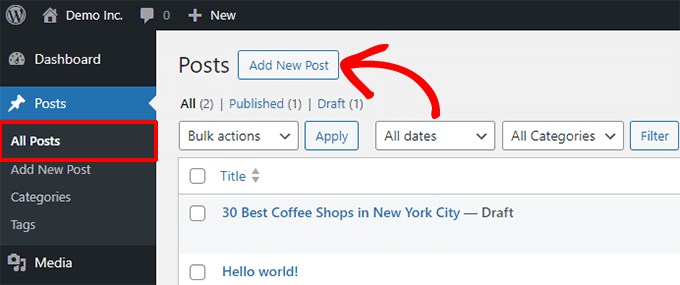
Isso abrirá o editor de blocos.
Como adicionar um bloco no Block Editor
O primeiro bloco de cada post ou página é o título.
Você pode usar o mouse para mover-se abaixo do título ou pressionar a tecla Tab no teclado para mover o cursor para baixo e começar a escrever.
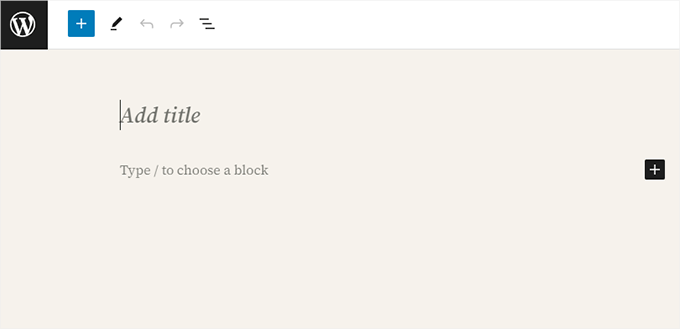
Por padrão, o próximo bloco é um bloco de parágrafo. Isso permite que os usuários comecem a escrever imediatamente.
No entanto, se quiser adicionar algo diferente, você poderá clicar no botão Adicionar novo bloco [+] no canto superior esquerdo do editor, abaixo de um bloco existente ou à direita de um bloco.
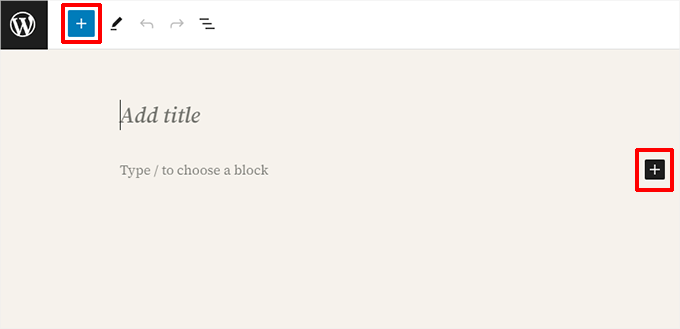
Ao clicar no botão, será exibido o menu Adicionar bloco com uma barra de pesquisa na parte superior e os blocos mais usados abaixo.
Você pode clicar nas guias para navegar pelas categorias de blocos ou digitar uma palavra-chave para pesquisar rapidamente um bloco específico.
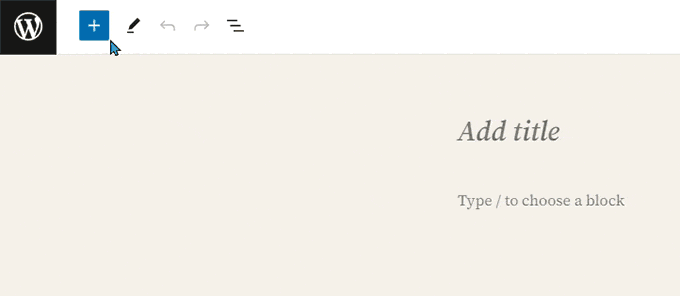
Se não quiser usar o mouse para clicar no botão, você também pode usar um atalho de teclado.
Comece digitando / para procurar um bloco e, em seguida, insira-o pressionando a tecla Enter no teclado.
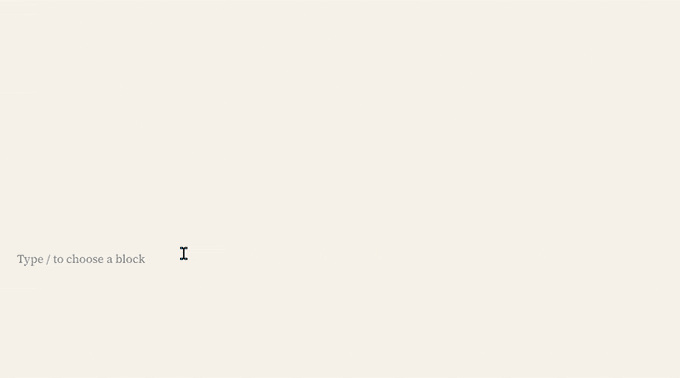
Trabalhando com blocos no novo editor
Cada bloco tem uma barra de ferramentas que aparece na parte superior. Os botões da barra de ferramentas mudam de acordo com o bloco que está sendo editado.
Por exemplo, na captura de tela abaixo, estamos trabalhando em um bloco Parágrafo que mostra botões básicos de formatação, como alinhamento de texto, negrito, itálico, inserir link e outras opções disponíveis no menu de três pontos.
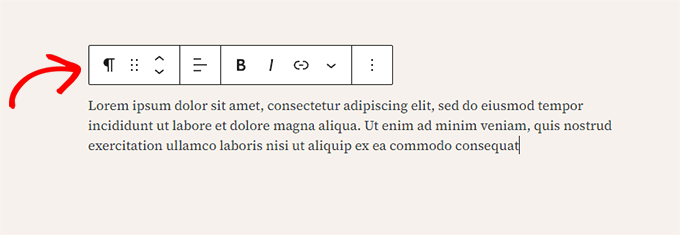
Além da barra de ferramentas, cada bloco pode ter suas próprias configurações de bloco, que aparecem na coluna direita da tela de edição.
Essas configurações variam de acordo com o bloco que está sendo editado. Por exemplo, o bloco Parágrafo permite que você edite a cor do texto, do plano de fundo e do link, bem como a tipografia.
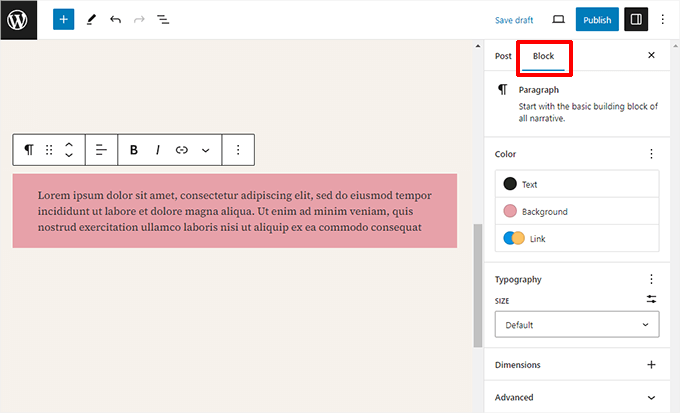
Você pode mover os blocos para cima e para baixo e reorganizá-los.
Se você quiser fazer isso, basta clicar para arrastar ou soltar ou clicar nos botões para cima e para baixo na barra de ferramentas do bloco.
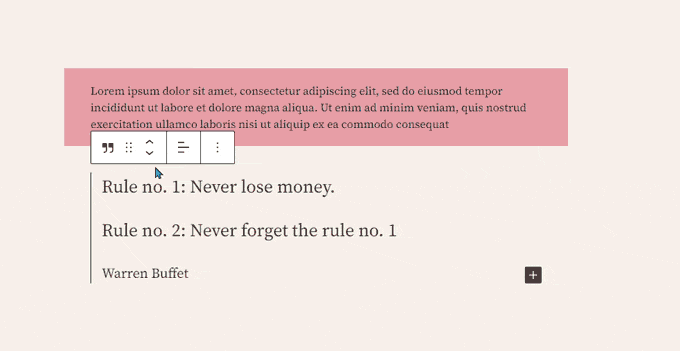
Relacionado: Veja nosso guia sobre como remover um bloco no WordPress.
Organização de blocos em grupos e colunas
O editor de blocos também vem com ferramentas úteis para gerenciar e organizar seus layouts de conteúdo.
Você pode selecionar vários blocos clicando neles enquanto pressiona a tecla Shift no teclado.
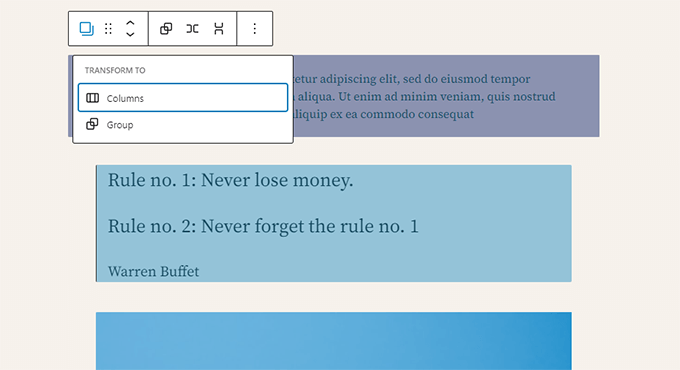
Depois disso, clique no botão de tipo de bloco na barra de ferramentas para transformar os blocos selecionados em Grupos ou Colunas.
Em seguida, você pode aplicar estilos a todo o bloco Group, como alterar o alinhamento ou o espaçamento.
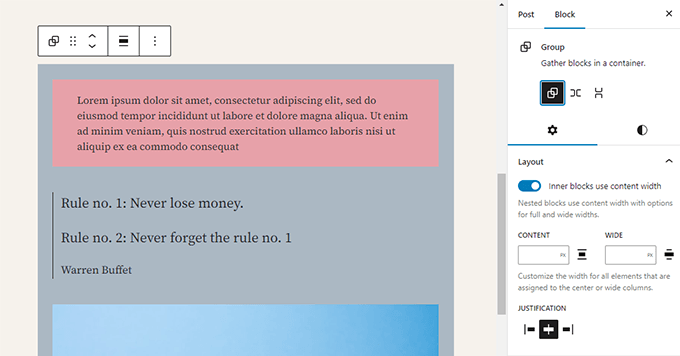
O editor de blocos também permite que você adicione um bloco vazio do tipo Group ou Columns.
Depois disso, você pode preenchê-los com outros blocos.
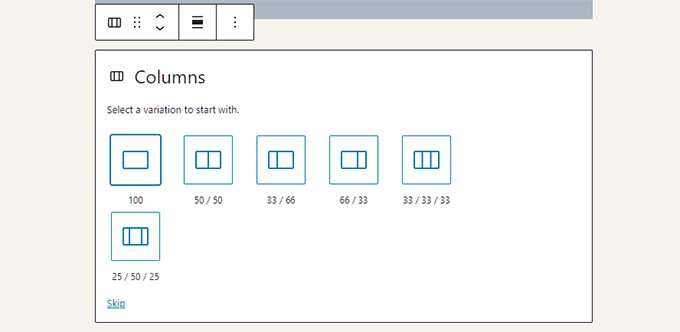
Você pode adicionar qualquer tipo de bloco em cada coluna, conforme necessário.
Isso permite que você crie belos layouts para diferentes casos de uso.
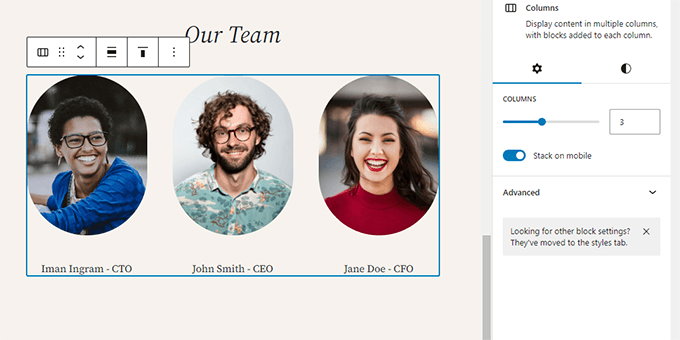
Salvar e reutilizar blocos no Gutenberg
Um dos melhores aspectos do uso de blocos é que eles podem ser salvos e reutilizados. Isso é particularmente útil para proprietários de sites e blogueiros que frequentemente precisam adicionar snippets de conteúdo específicos a seus artigos ou páginas.
Basta clicar no botão de menu no canto direito da barra de ferramentas de cada bloco. No menu, selecione a opção “Create Pattern” (Criar padrão).
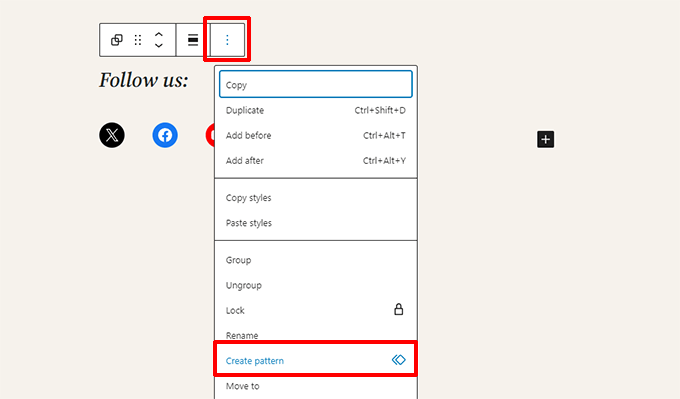
Observação💡: Você também pode usar grupos e colunas inteiros como blocos reutilizáveis. Isso permite salvar seções inteiras e usá-las sempre que necessário.
Isso abrirá uma janela pop-up na qual você precisará fornecer um nome para esse padrão. Pode ser qualquer coisa que o ajude a identificar facilmente quando precisar reutilizá-lo.
Em seguida, você pode, opcionalmente, escolher categorias. Isso o ajuda a classificar seus padrões de forma organizada.
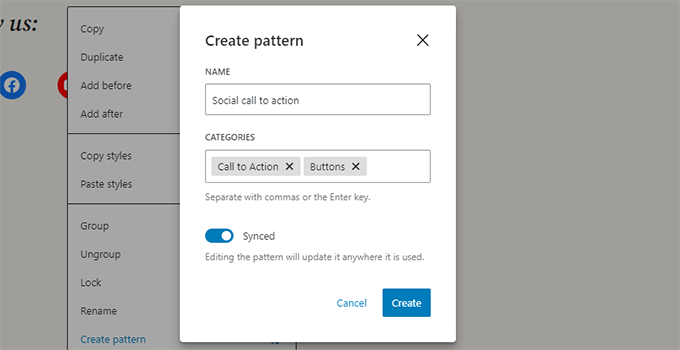
Em seguida, clique no botão “Create” (Criar) para salvar seu padrão. O WordPress armazenará seu padrão com todos os blocos dentro dele.
Para reutilizar seu padrão, basta editar o post ou a página em que você deseja adicioná-lo.
Em seguida, clique no botão [+] adicionar bloco ou use o atalho de teclado /. Você pode encontrar o padrão digitando o nome que lhe deu.
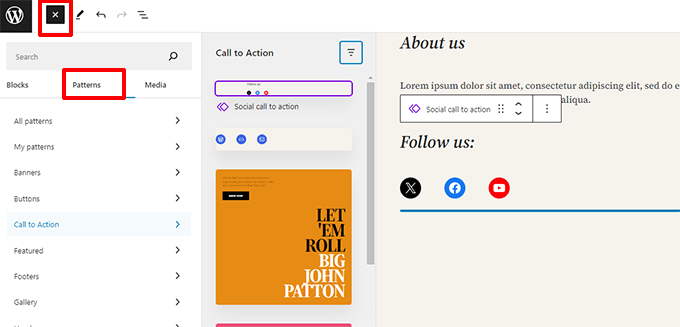
Os padrões facilitam para os proprietários de sites a adição de elementos comumente usados em seus layouts, como chamadas para ação, botões de mídia social, banners e muito mais.
Seu tema ou plug-ins do WordPress podem até vir com seus próprios padrões, ou você pode encontrar padrões criados por outras pessoas na biblioteca de padrões de blocos do WordPress.
Se você precisar de mais ajuda, temos um guia separado para iniciantes sobre como encontrar e usar padrões de blocos do WordPress.
Opções de publicação e gerenciamento no Gutenberg Block Editor
Cada post do WordPress contém muitos metadados. Isso inclui informações como a data de publicação, categorias e tags, imagens em destaque e muito mais.
Todas essas opções estão bem posicionadas na coluna direita da tela do editor.
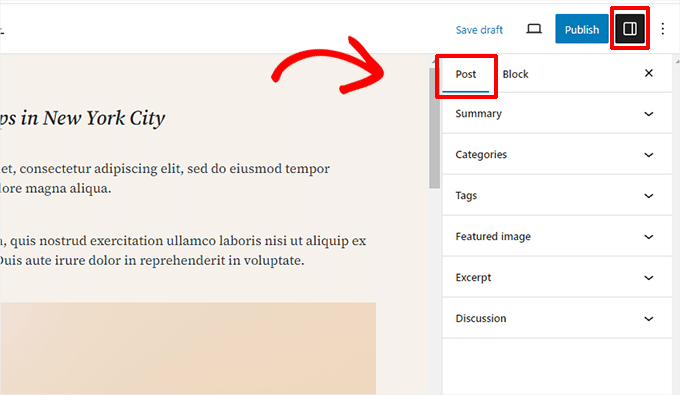
Opções de plug-in no Gutenberg
Os plug-ins do WordPress podem aproveitar a API do editor de blocos para integrar suas configurações na tela de edição.
Alguns plug-ins populares vêm com seus próprios blocos.
Por exemplo, o WPForms, o melhor plugin de formulário de contato do WordPress, permite adicionar formulários ao seu conteúdo usando um bloco.
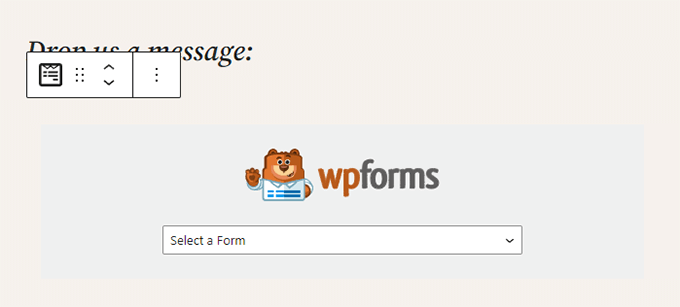
Outros plug-ins do WordPress também podem adicionar suas configurações à tela do editor de blocos.
Por exemplo, veja como o All in One SEO para WordPress permite que você edite suas configurações de SEO na parte inferior do editor de blocos:
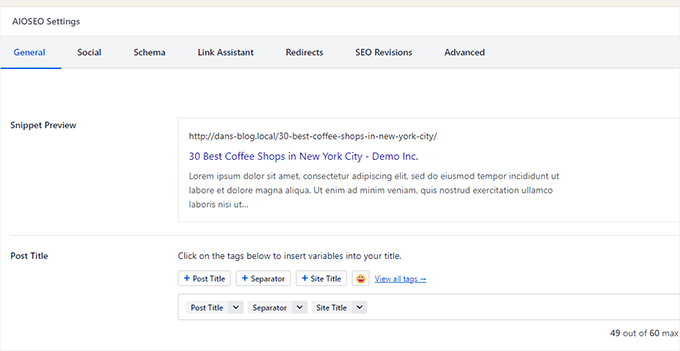
Da mesma forma, se você tiver uma loja on-line usando o WooCommerce, perceberá que ele também tem seus próprios blocos.
Esses blocos permitem que você adicione seus produtos a qualquer um dos posts e páginas do WordPress.
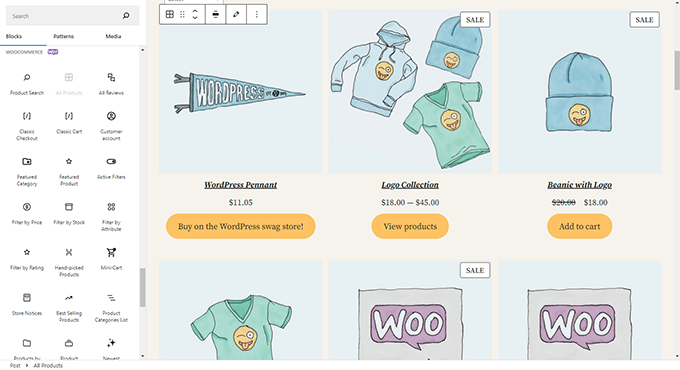
Adição de alguns blocos comuns no Block Editor
O editor de blocos pode fazer tudo o que o editor clássico antigo fazia.
No entanto, você fará as coisas de forma mais rápida e elegante do que antes. Além disso, ele pode fazer muito mais, como permitir que você estilize seu conteúdo com várias opções sem código.
Aqui estão alguns dos blocos comuns que você pode usar.
1. Adição de uma imagem no editor de blocos do WordPress
Há um bloco de imagem pronto para uso no editor de blocos do WordPress. Basta adicionar o bloco e, em seguida, carregar um arquivo de imagem ou selecioná-lo na biblioteca de mídia.
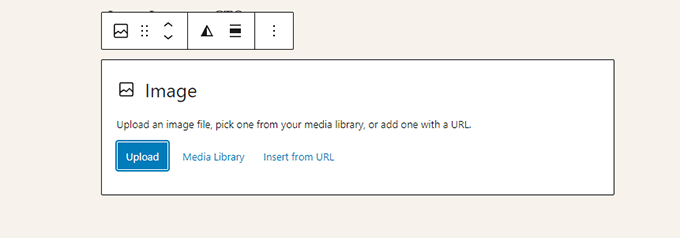
Você também pode arrastar e soltar imagens do seu computador, e o editor criará automaticamente um bloco de imagem.
Depois de adicionar uma imagem, você poderá ver as configurações do bloco, onde poderá adicionar metadados para a imagem, como o texto alternativo, o tamanho da resolução da imagem e adicionar um link para a imagem.
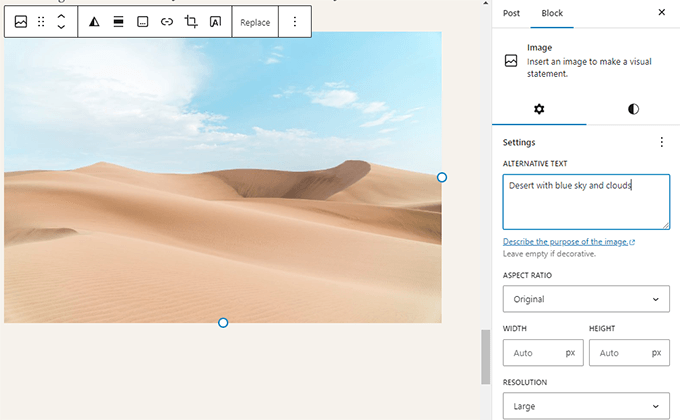
Para obter mais informações, dê uma olhada em nosso tutorial sobre como adicionar imagens no WordPress.
2. Adição de um link no Block Editor
O editor de blocos vem com vários blocos nos quais você pode adicionar texto. O mais comumente usado é o bloco Parágrafo, que tem um botão de inserção de link na barra de ferramentas.
Todos os outros blocos de texto comumente usados também têm um botão de link na barra de ferramentas.

Você também pode inserir um link usando o atalho de teclado, que é Command + K para Mac e CTRL + K em computadores Windows.
3. Adição de uma galeria de imagens no Gutenberg
O bloco Gallery funciona como o bloco de imagens. Você o adiciona e, em seguida, carrega ou seleciona arquivos de imagem.
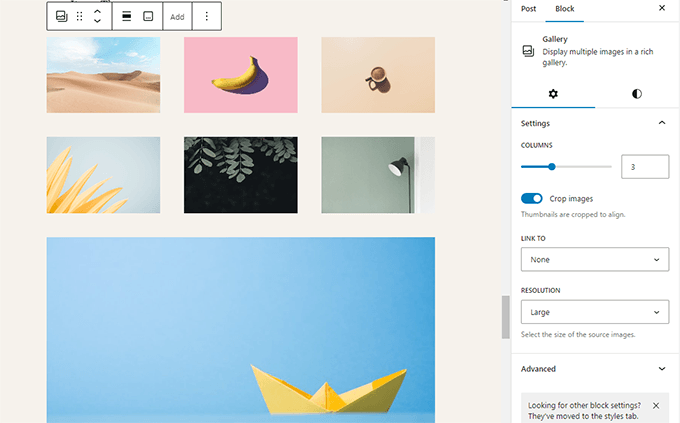
Para obter mais detalhes, consulte nosso guia sobre como criar uma galeria de imagens no WordPress.
4. Como adicionar códigos de acesso em publicações do WordPress usando o Gutenberg
Todos os seus códigos de acesso funcionarão exatamente como no editor clássico. Você pode simplesmente adicioná-los a um bloco Paragraph ou usar o bloco Shortcode.
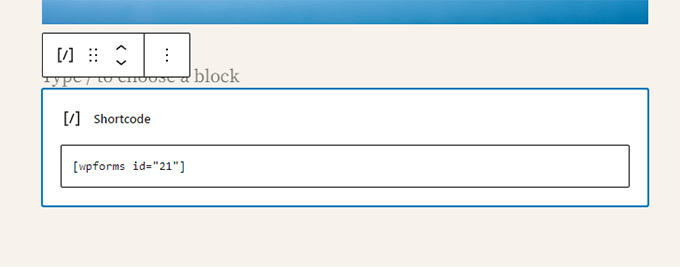
Explorando outros blocos de conteúdo no Block Editor
O editor Gutenberg prometeu resolver alguns problemas de usabilidade de longa data no WordPress com a introdução de novos blocos.
A seguir estão alguns dos favoritos que acreditamos que os usuários acharão imensamente úteis.
1. Como adicionar uma imagem ao lado de um texto no WordPress
Muitos de nossos usuários não conseguiam colocar uma imagem ao lado do texto usando o editor antigo. Agora é possível fazer isso com o bloco Mídia e texto.
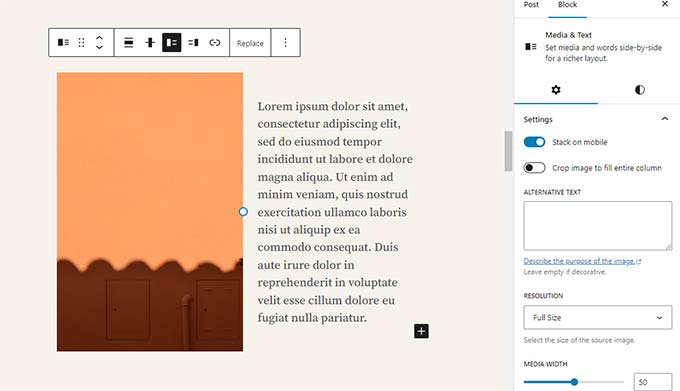
Esse bloco simples vem com dois blocos colocados lado a lado, permitindo que você adicione facilmente uma imagem com algum texto ao lado.
2. Adição de um botão em posts e páginas do WordPress
Outro incômodo do antigo editor era adicionar um botão aos posts ou páginas do blog. Você tinha que usar um plug-in que criava um shortcode para o botão ou mudar para o modo HTML e escrever o código.
Felizmente, o Gutenberg tem um bloco Button que permite que você adicione rapidamente um botão a qualquer post ou página.
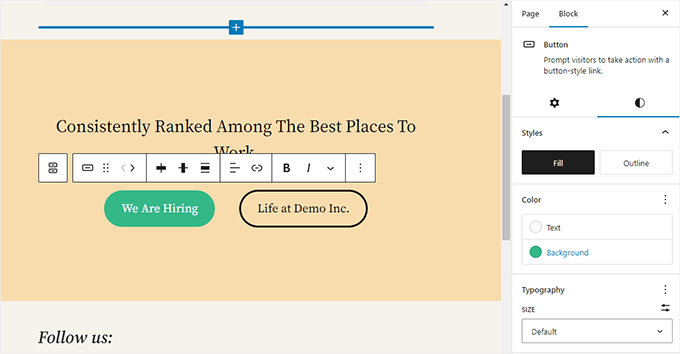
Você pode adicionar um link ao seu botão, alterar as cores e muito mais. Para obter detalhes, consulte nosso artigo sobre como adicionar botões facilmente no WordPress.
3. Adição de belas imagens de capa em publicações de blog e páginas de destino
Outro recurso interessante que você pode querer experimentar é o Cover block, que permite adicionar imagens de capa ou capas de fundo coloridas aos seus posts e páginas.
Uma imagem de capa é uma imagem mais ampla, geralmente usada para uma nova seção em uma página ou para o início de uma história. Ela é bonita e permite que você crie layouts de conteúdo envolventes.
Basta adicionar um bloco Cover e carregar a imagem que você deseja usar. Você pode escolher uma cor de sobreposição para a capa ou torná-la uma imagem de fundo fixa para criar um efeito de paralaxe quando os usuários rolarem a página para baixo.
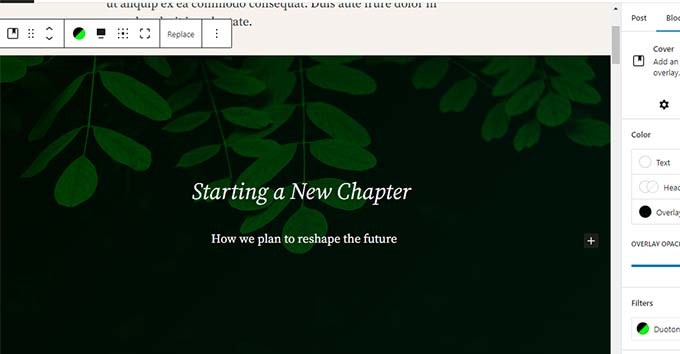
Para obter mais detalhes, consulte nosso artigo sobre a diferença entre imagens de capa e imagens em destaque no WordPress.
4. Criação de tabelas em artigos
O editor clássico não tinha um botão para adicionar tabelas às suas postagens do WordPress. Era necessário usar um plug-in ou criar uma tabela escrevendo CSS e HTML personalizados.
Agora, o editor de blocos tem um bloco Table padrão, o que torna muito fácil adicionar tabelas aos seus posts e páginas. Basta adicionar o bloco e selecionar o número de colunas e linhas que deseja inserir.

Agora você pode começar a adicionar dados às linhas da tabela. Você sempre pode adicionar mais linhas e colunas, se necessário, e há duas opções básicas de estilo disponíveis.
5. Criação de conteúdo com várias colunas
A criação de conteúdo com várias colunas era outro problema com o qual o editor clássico não lidava.
Felizmente, o editor de blocos permite que você adicione um bloco Columns, que adiciona duas colunas de blocos de parágrafos.
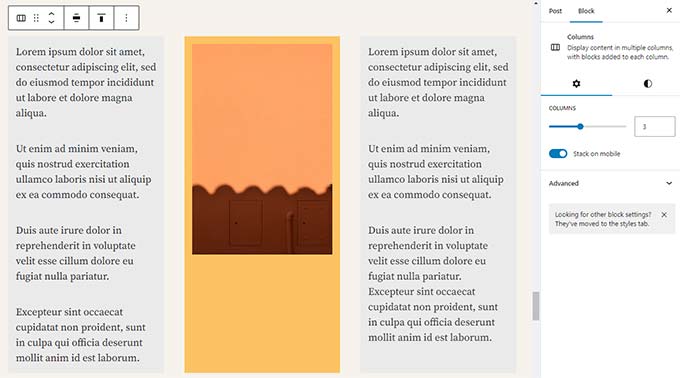
Esse bloco de colunas é bastante flexível. Você pode adicionar até 6 colunas em uma linha e até mesmo usar outros blocos dentro de cada coluna.
Dicas de bônus para usar o Gutenberg como um profissional
Observando o editor de blocos, você pode se perguntar se passará mais tempo adicionando e ajustando blocos do que criando conteúdo real.
Bem, o editor de blocos é incrivelmente rápido, e mesmo o uso básico por alguns minutos permitirá que você adicione blocos instantaneamente, sem nem pensar.
Em breve, você perceberá como seu fluxo de trabalho se tornará muito mais rápido com essa abordagem.
Aqui estão algumas dicas de bônus para usuários avançados para ajudá-lo a trabalhar ainda mais rápido com o editor de blocos do WordPress.
1. Mova a barra de ferramentas de blocos para a parte superior
Você deve ter notado nas capturas de tela acima que uma barra de ferramentas aparece na parte superior de cada bloco. Você pode mover essa barra de ferramentas para a parte superior do editor.
Para acessar a opção “Barra de ferramentas superior”, clique no botão de três pontos no canto superior direito da tela.
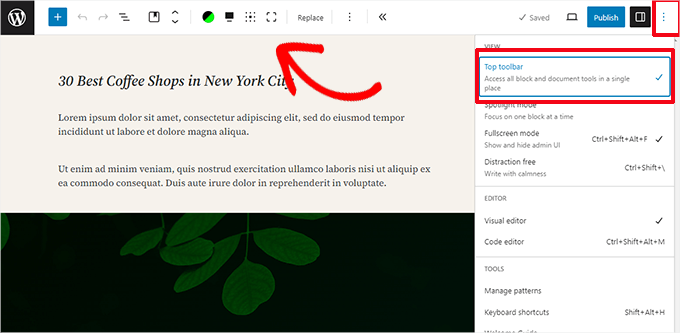
2. Usar atalhos de teclado
O Gutenberg vem com vários atalhos úteis que tornarão seu fluxo de trabalho ainda mais rápido e fácil. O primeiro que você deve começar a usar imediatamente é o /.
Basta digitar /, começar a digitar e o editor mostrará os blocos correspondentes que você pode adicionar imediatamente.
Para obter mais atalhos, clique no menu de três pontos no canto superior direito da tela e selecione “Atalhos do teclado”.
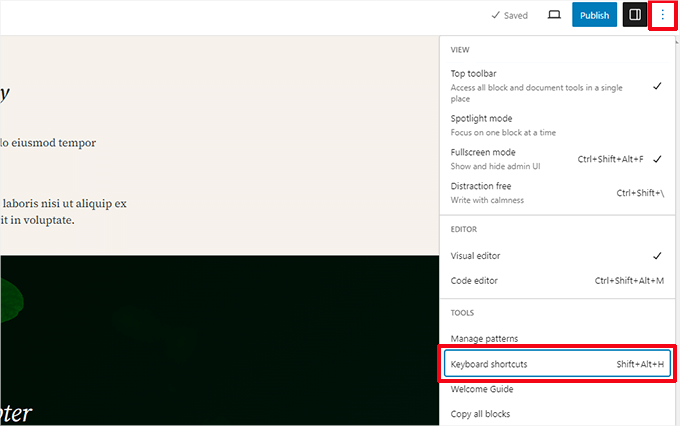
Isso abrirá uma janela pop-up com uma lista de todos os atalhos de teclado que você pode usar. A lista terá atalhos diferentes para usuários de Windows e Mac.
3. Arraste e solte a mídia para criar automaticamente blocos de mídia
O Gutenberg permite que você arraste e solte arquivos em qualquer lugar da tela, criando automaticamente um bloco para você.
Por exemplo, você pode soltar um único arquivo de imagem ou vídeo e ele criará o bloco para você. Como alternativa, você pode soltar vários arquivos de imagem para criar um bloco do Gallery.
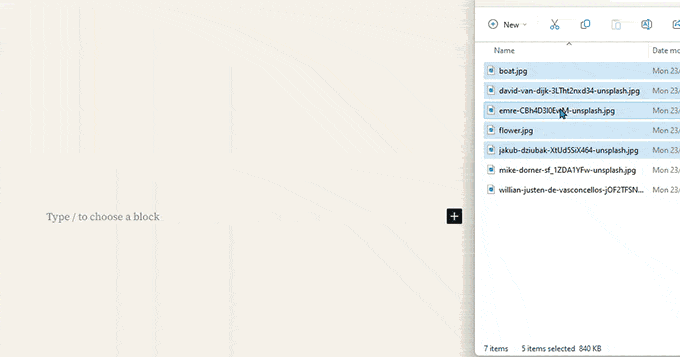
4. Adição de YouTube, Twitter, Vimeo e outras incorporações
O editor de blocos facilita a incorporação de conteúdo de terceiros em seu conteúdo do WordPress. Há blocos para todos os serviços populares de terceiros.
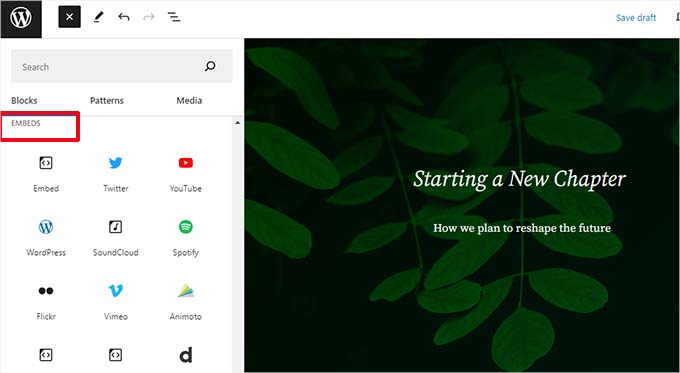
No entanto, você pode simplesmente copiar e colar o URL incorporado em qualquer ponto, e ele criará automaticamente um bloco para você.
Por exemplo, adicionar um URL de vídeo do YouTube criará automaticamente um bloco incorporado do YouTube e exibirá o vídeo.
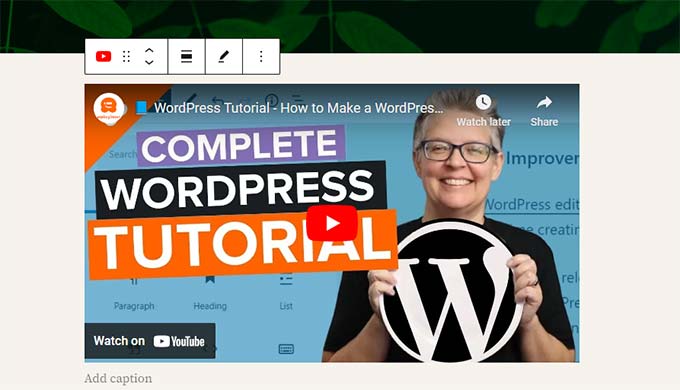
A opção de incorporação padrão não funcionará para incorporações do Facebook e do Instagram, mas há uma solução alternativa. Consulte nosso artigo sobre como incorporar publicações do Facebook e do Instagram no WordPress.
Adicionando mais blocos ao Gutenberg Block Editor no WordPress
O editor de blocos do WordPress permite que os desenvolvedores criem seus próprios blocos. Alguns excelentes plug-ins do WordPress oferecem pacotes de blocos para o novo editor.
Aqui estão alguns deles:
1. Blocos de Gutenberg do Spectra WordPress

OSpectra WordPress Gutenberg Blocks é uma biblioteca de blocos com muitos blocos avançados que ajudam você a adicionar mais elementos de design ao seu conteúdo.
O Spectra, criado pelo pessoal por trás do popular tema Astra para WordPress, ajuda você a criar belos designs sem escrever nenhum código.
Para obter mais informações, consulte nossa análise completa do Spectra.
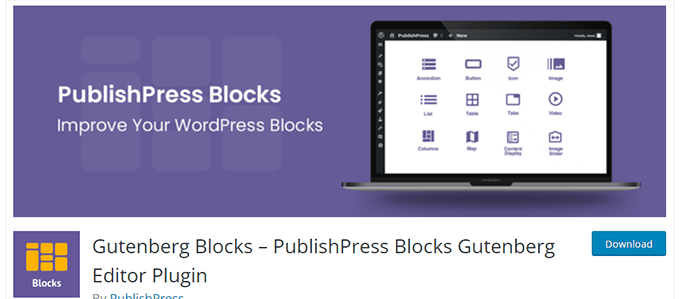
OPublishPress Blocks é outra biblioteca de blocos avançada que vem com blocos adicionais para ampliar o editor de blocos do Gutenberg.
Ele inclui belas opções de layout, controles deslizantes, botões, ícones, galerias de imagens, mapas, guias, depoimentos, acordeões e muito mais.
3. Empilhável – Blocos de Gutenberg
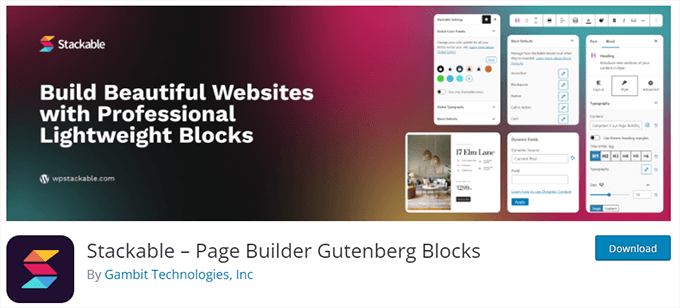
OStackable – Gutenberg Blocks é uma coleção de blocos do Gutenberg lindamente projetados que você pode usar em seu site. Ela inclui blocos para o contêiner, postagens, grade de recursos, acordeão, caixa de imagem, lista de ícones, chamada para ação e muito mais.
Para obter mais algumas opções, consulte nossa lista completa dos melhores plug-ins de bloco do WordPress Gutenberg.
Perguntas frequentes sobre o Gutenberg – O editor de blocos no WordPress
Desde que o Gutenberg se tornou o editor padrão do WordPress, temos recebido muitas perguntas sobre como usá-lo. Aqui estão as respostas para algumas das perguntas mais frequentes sobre o editor de blocos.
1. O que acontece com meus posts e páginas mais antigos no editor de blocos? Ainda posso editá-los?
O editor de blocos não afeta seus posts e páginas antigos. Você ainda pode editá-los, e o editor de blocos os abrirá automaticamente em um bloco que contém o editor clássico.
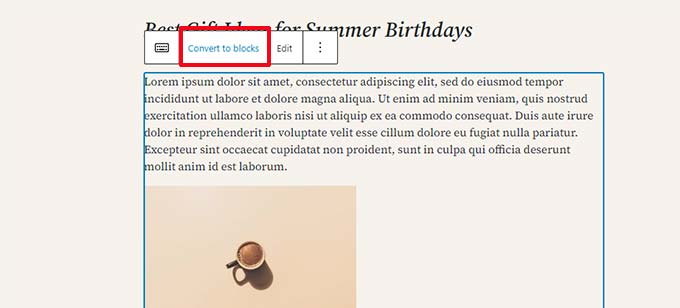
Você pode editá-los no editor antigo ou pode converter artigos antigos em blocos e usar o editor de blocos.
2. Ainda posso continuar usando o editor antigo?
Sim, você ainda pode continuar usando o editor antigo. Basta instalar e ativar o plug-in Classic Editor.
Após a ativação, o editor de blocos será desativado, e você poderá continuar usando o editor clássico.
Observe que o Editor Clássico terá suporte até 2025. Para se familiarizar com o editor de blocos, comece a usá-lo agora.
3. O que devo fazer se o editor de blocos não funcionar com um plug-in ou tema que estou usando?
O Projeto Gutenberg estava em desenvolvimento há muito tempo, o que deu aos autores de plug-ins e temas bastante tempo para testar a compatibilidade de seus códigos.
No entanto, ainda há uma chance de que alguns plug-ins e temas não funcionem bem com o editor de blocos. Nesse caso, você pode instalar o plug-in Classic Editor, solicitar ao desenvolvedor que adicione suporte ao Gutenberg ou encontrar um plug-in ou tema alternativo.
4. Como posso saber mais sobre as dicas e os truques do Gutenberg?
O WPBeginner é o melhor lugar para aprender sobre o editor de blocos do WordPress. Somos o maior site de recursos do WordPress na Internet.
Publicaremos novos artigos e atualizaremos nossos recursos antigos para ajudá-lo a dominar o editor de blocos.
Enquanto isso, se tiver alguma dúvida, sinta-se à vontade para entrar em contato conosco deixando um comentário ou usando o formulário de contato em nosso site.
5. Está tendo problemas com o Gutenberg?
Se você estiver tendo problemas com o editor de blocos do WordPress, criamos um guia rápido de solução de problemas que lista todos os problemas comuns do editor de blocos que os usuários encontram e como corrigi-los.
Tutorial em vídeo
Se você não preferir instruções por escrito, assista ao nosso tutorial em vídeo:
Recursos de bônus
Veja a seguir alguns recursos adicionais que o ajudarão a usar o editor de blocos com mais eficiência:
- WordPress Block Editor vs. Page Builders: Qual é a diferença?
- Como criar um bloco personalizado no WordPress (maneira fácil)
- Como importar/exportar seus blocos do WordPress Gutenberg (2 etapas)
- Widgets e blocos do WordPress – Qual é a diferença? (Explicado)
- Um guia completo para iniciantes sobre a edição completa de sites no WordPress
- Melhores temas de bloco para edição completa do site no WordPress
- Dicas para dominar o editor de conteúdo do WordPress
Se você gostou deste artigo, inscreva-se em nosso canal do YouTube para receber tutoriais em vídeo sobre o WordPress. Você também pode nos encontrar no Twitter e no Facebook.





jeff
I inserted a hyperlink on a phrase and I want to change the font color for that phrase. how do I do that? please help
WPBeginner Support
If only for that specific phrase, you would need to edit the text as HMTL to add styling to that phrase at the moment
Admin
Anne
Hello!
I created a column block with 3 columns. Added content and everything was distributed across the page width equally. Then I added a 4th column and now the column block no longer distributes across the entire page width. It’s seems like it has “squooshed” (sorry, can’t think of a better word right now), all 4 columns and shrunk the info as well. I tried various alignments for each individual column and it still would not spread the entire block back out. Hope this makes sense and hope you can help. Thanks!!
WPBeginner Support
It sounds like what you added to your largest column has a minimum width that is not allowing the content to adjust which would be the root of your problem.
Admin
Mark Watts
I’m struggling with the Gutenberg block editor. Heres a couple of questions but there will surely be many more to come.
How do I add a pdf document so it opens when I click a link? Used to create and highlight the link text then select “add media” and all worked fine.
When I try to add a link from within the paragraph block I no longer see a list of possible pages and posts so that I can chose. How do I get this list.
WPBeginner Support
You would manually need to take the link from the document in your media library unless you wanted to embed it. In the paragraph block, there is the link button which is third from the right, as you type into it the dropdown should appear
Admin
Tuan
This upgrade so stupid. I spent more time to write. Haiz
WPBeginner Support
Learning a new interface can certainly be troublesome but as the interface improves it should slowly become better to use
Admin
Jennifer
I’ve searched and can’t find an applicable answer to my issue, so I’m hoping you can help me.
I upgraded to the new block system for our website this past week. I need to find and copy the url for one of our buttons (it’s a redirect to PayPal), but I can’t find the url anywhere.
There’s no “edit button” when I hover over the button in the block. I checked the html and couldn’t find it there, either – the only thing I could see were the image files for the button itself.
Clicking on the button live still redirects correctly, so I know the link is working – I just can’t find it.
Any advice?
Thanks!
Jennifer
WPBeginner Support
When you select the block there should be the block settings on the right-hand side where you would find the link settings for where the button links to if it was transferred as an image. If it is a button block then there should be the url beneath the button where you can edit it.
Admin
Franklyn Fosu
Please help me resolve the “Update failed” issue when trying to publish my articles using the Gutenberg.
WPBeginner Support
To start, you would want to go through the steps in our troubleshooting guide: https://www.wpbeginner.com/beginners-guide/beginners-guide-to-troubleshooting-wordpress-errors-step-by-step/
For a temporary workaround, you could also enable the classic editor plugin and reach out to the support for Gutenberg.
Admin
Carlos Goncalves
How to use the new advanced Css option. I Tried to put some code there, but It´s not run.
WPBeginner Support
That is for adding a class to the object, you would want to take a look at our explanation of CSS to understand classes better: https://www.wpbeginner.com/glossary/css/
Admin
Candi Clark
On the top right of my block edit page, it doesn’t say publish. The button says update. When I click that button it says page has updated but when I go take a look at it on my website it hasn’t changed. Did something not upgrade correctly to have that button not say publish?
WPBeginner Support
You may want to check any caching that you have on your site that could be causing the problem.
Admin
Jim Kielbaso
How do I go back to the old version? There was nothing wrong with it, and this version does not add anything. In fact, it makes it MUCH more confusing. It is NOT user-friendly, and it has been very frustrating. Upgrades should only be made to improve something, not just for the sake of changing.
WPBeginner Support
The new editor was created to help those new to WordPress have less of a barrier to entry. For those who prefer the old editor, there is the Classic Editor plugin and we explain that plugin in our article here: https://www.wpbeginner.com/plugins/how-to-disable-gutenberg-and-keep-the-classic-editor-in-wordpress/
Admin
Sufyan Shaikh
Good article.
WPBeginner Support
Thank you
Admin
AlannaMH
How do I change the font of text in blocks?
WPBeginner Support
For setting up your site’s font, you would want to take a look at our article here: https://www.wpbeginner.com/wp-themes/how-to-add-custom-fonts-in-wordpress/
Admin
Viktor
Time consuming, if you go to WP you will see very negative comments
For me the solution was to activate a plugin called “Disable Gutenberg”
I understand there´s a learning curve…but I pass..sorry
WPBeginner Support
If you’re not ready to use the Gutenberg editor then using a plugin like that is certainly understandable.
Admin
Frank Kinghorn
I am a complete novice in website writing and decided to use WP because it seemed to have good support. At that time I did not realise WPbeginner existed but wow! now that I’ve found various guides from wpbeginner I am convinced that I made the right choice. Specifically, this guide on the new editor is fantastic. Even its existence helped me out of a deep hole: I have installed WP on my pc so I can play with it before starting my first real website but got stumped because when I got to the stage of trying to edit a page there was no sign of the editor shown in the “Getting Started with WordPress” guide by iThemes. I spent hours trying to see if my download to my pc was corrupted or if I was missing something simple – now I know the classic editor has been replaced! Sorry for the long post but a real thank you for this guide and the several other documents I have found from WPbeginner.
WPBeginner Support
Thank you, glad our site and articles could help you get up and running with WordPress
Admin
vivek
everytime i try to publish ..all i get is Auto Draft.
cant understand what is going on
WPBeginner Support
For a starting point, you may want to go through our troubleshooting article here: https://www.wpbeginner.com/beginners-guide/beginners-guide-to-troubleshooting-wordpress-errors-step-by-step/
Admin
Aaron P
Thanks for a great article! This really helped me make the transition. I was hesitant to switch, but now that I’ve played around for a while I like the new block editor.
WPBeginner Support
You’re welcome, glad our article could ease the transition
Admin
Matthew Pan
Hi, thanks for this, was really helpful.
May I ask, for adding a button block, I’m currently unable to add one such that it opens up in a new tab. There used to be an easy checkbox for this. Do you know how to do so?
2. Adding a button in WordPress posts and pages
Thanks!
WPBeginner Support
When adding a link you should have an option with three dots that you can click to have the open in new tab option again.
There is a button block you can use to add a button to your posts and pages
Admin
sally
How do I use Grammarly app with this new editor, because I cannot see Grammarly popping down there to correct my mistakes or even show me my mistakes? Thank you.
WPBeginner Support
Once you reach the second line in a paragraph block the Grammarly check should appear in the bottom corner. If it’s not appearing you could reach out to Grammarly’s support and they should be able to help ensure it appears correctly in your editor.
Admin
Linn
Hi, as a brandnew beginner, I took two courses on WordPress 5 by Morten on Lynd. Gutenberg is easy to use. However, I still don’t know how to build header and footer with Gutenberg. I need a full width color background, onto which I add several buttons such as “about,” “services,” “products,” etc. Can you help?
WPBeginner Support
Headers and footers styling is normally handled from your theme, you would either need knowledge of HTML, CSS, and PHP or you could take a look at our article here: https://www.wpbeginner.com/wp-themes/how-to-easily-create-a-custom-wordpress-theme/
Admin
Ima
Do you know if they have been able to fix the scrolling issue in the block editor? It is really annoying that you can’t scroll to the bottom of the block section without having to go to the Settings section and scroll there. I have googled and googled some more, and I am not finding a solution. Thanks so much!
WPBeginner Support
Unless I hear otherwise, the error shouldn’t be an issue but you could reach out to the WordPress.org support for if the specific error you are running into was resolved.
Admin
Steve Briese
Come on, folks. These are not the people who created WordPress. These are the people who are kind enough to help you adjust to the blocks. How many times do they need to tell you to install the Classic Editor plugin if you don’t like blocks? I don’t know if I like blocks or not, but I feel more confident in testing them after reading this introduction. Thank You!
WPBeginner Support
Glad our article could help
Admin
Sandeep
Hi, after I installed WordPress 5.1 , using Gutenberg if go to write text, on top of first word one line will come . I am not getting what’s issue. Can tell how to solve this
WPBeginner Support
Have you tried disabling all of your plugins to see if this could be a plugin specific issue?
Admin
Denny Gibson
I’ve found no way to wrap text around images. Am I missing something or is this not as popular as I thought?
WPBeginner Support
You would want to use the Media&Text block to have your text wrap with the block editor
Admin
Tom Schulte
Is there a way to still code in html in the block editor?
I ask this because the block editor inserted an extra wide space between 2 lines which I did not want. I could and did use the classic editor’s text option to get rid of the extra space.
WPBeginner Support
Yes, you can use the ellipses in the top right to swap to HTML or you could use a classic block if you only wanted to edit a specific section in HTML
Admin
Rick Swift
I grudgingly started using this new block mentality, and I wasn’t happy about it. I am glad I found your article, though, because it has made navigating this new concept much easier.
Wondering if anyone has had this experience though. While adding tags to my Document, I will add the tags, hit enter and the little box doesn’t expand at all. I have NO idea how to see my tags that I have entered.
I use WooThemes – Canvas
Very frustrating experience right now.
WPBeginner Support
If you have not already, you may want to try disabling your plugins and/or swapping themes to see if it is a conflict with one of those that is preventing the auto-expanding tag section from displaying properly.
Admin
Charles
Maybe one day I will figure out how to use this, but at the moment it seems impossible. I have used over a dozen word processors, and various web editors, but that experience is not helping me now.
I would like to indent a number of paragraphs. Sounds simple, but I have not found a way to do it. What is the use of having a paragraph block that can’t indent?
Last time I gave up on putting in a table and went back to editing HTML in the old system.
WPBeginner Support
While the paragraph block does not have an indent option at the moment, should you use the block editor again you could add an indent using the Classic block
Admin
Craig Wallace
So the concept of allocating a Template to a new page is gone?
As far as I can see, when you are making a new page ‘from blocks’ there is not way to select a template that you may have constructed in the old way? (i.e. the drop down for templates is no where to be seen).
WPBeginner Support
You would want to check under page attributes to set the template for a page if your current theme has templates.
Admin
Nina Haeringer
How do you increase font size in a list block? I have looked everywhere. I am new to WordPress and find it not very user friendly but I’m trying to get the hang of it. I need to be able to increase list block font size. Please help.
WPBeginner Support
You would need to manually add CSS to change that font size or you could use a plugin such as CSS Hero:
https://www.wpbeginner.com/plugins/css-hero-review-wordpress-design-customization-made-easy/
For how to find the CSS you need to change you can use inspect element which we explain how to use in our article here: https://www.wpbeginner.com/wp-tutorials/basics-of-inspect-element-with-your-wordpress-site/
Admin
Mario Garcia
I just installed the new Word Press (blocks) and I am having trouble because Ido the title block fine, then whatever I type for the second block appears duplicated when I do the preview: I see that block under the title TWICE in the post. What am I doing wrong?
WPBeginner Support
You may want to check with your theme’s support to ensure that this is not a style of your specific theme
Admin
Ericka
I’m trying to navigate the new Block editor. I’m simply looking for the “read more” button that you use to be able to simply click a button on the Classic editor and it would place the “read more” button to divide the text on the home page.
WPBeginner Support
It was renamed into the More block
Admin
TEGA PERKINS ODJEGBA
How do I increase the size of my block, I have read through the guide several times. You did not address that.
If I want to increase the writings in a block, how do I do that, and is it possible to join two block?
WPBeginner Support
It would depend on what you’re trying to change. You can copy and paste the content then remove the block you moved the content from but there is not a simple merge button at the moment. If you’re looking for the font size, that is normally governed by your theme’s CSS
Admin
Kelsey
I can’t figure out how to do a “read more” option so that the first few sentences of a blog show up as a preview on the main blog page. Any insight? Also is there a way to change the colour of the font of hyperlink? Thanks!!
WPBeginner Support
You would want to add the More block to use the read more function. For the hyperlink color, you would want to modify the CSS, you can test the color changes you want to make using inspect element then copy the custom CSS to your Appearance>Customize>Additional CSS section: https://www.wpbeginner.com/wp-tutorials/basics-of-inspect-element-with-your-wordpress-site/
Admin
Vicky
Great introduction, thank you!
WPBeginner Support
You’re welcome
Admin
Curry
Under the classic edit I could place a picture within a paragraph and keep everything inside the margins. I have not been able to do it with Guttenberg. I have followed the instructions re: media-paragraph block and it appears to work fine. But when I switch to preview it places the picture before the paragraph. If I simple add a new bloick I can only place the picture left or right but then it is outside the margins of the script – which does not look good. Very frustrating. Looking for help.
WPBeginner Support
Your browser window may not be wide enough for the text to not automatically be placed below, you would want to reach out to the support for your specific theme to see if the styling needs to be updated for it to work with the block editor.
Admin
Curry
I have followed your instructions for placing an image next to text in the new Gutenberg Editor. It looks fine – until I click on Preview. It then shows up as a large picture prior to the text. I have been unable to get it to transfer into Preview correctly
WPBeginner Support
If you are on mobile it may be stacking the text and image due to the advanced settings for the image in that block.
Admin
Debra Oakland
Since this new format will no longer size my Fotolia cover photos as they wereiin the old editor, (I need them wide and narrow) I chose The Cover Block which widened and narrowed the photo. I put the title in the center of the cover block. The article says no title (obviously) so I need to change the permalink. I can’t delete the uncategorized and the number after it to put the proper permalink in. Just trying to work things out without going back to the old editor. Can’t find any info on changing this permalink. Hoping this makes sense. Thank you for this tutorial, it’s very helpful.
WPBeginner Support
For editing your image’s size you may want to use an image editor such as one in our article: https://www.wpbeginner.com/showcase/tools-to-create-better-images-for-your-blog-posts/
If you have your category in your permalink then you would need to change your category and manually save your draft for the permalink to update to the new category.
Admin
Silke
Hi, how do I assign a menu to the footer bar wo it appearing underneath as well? Atm I create a custom footer menu. By assigning it to ‘Footer menu’ in Dashboard/Appearance/Menus it automatically appears on the page. If I now assign it to the footer bar I’ll have the menu twice.
Here’s the problem: If I DON’t assign ‘footer menu’ to my custom footer menu it’s not available in the footer bar editor.
WPBeginner Support
Your theme may have a specific setting that could be causing an issue. If you reach out to your specific theme’s support and let them know about it not appearing/appearing twice
Admin
Mark Braunstein
I don’t have time to learn a new editor. Nor do I want to. Change is not always good. I have lost days of work. Thanks!
If it was better, then Microsoft Word would operate like Gutenberg. Really doesn’t matter. It needs to operate in a way we all know. Not some fancy theoretical method. Productivity is key, and if we cannot make it work, we have lost productivity. We dont need a better mousetrap, simply one that works. I guess I have to find another site platform.
I and I guess many others find it counter intuitive. There was once a button to use the Classic editor but now I cannot find it. I don’t want to keep adding plugins to my sight. They are fraught with bugs.
WPBeginner Support
We are not in control of the development of WordPress, we try to help people understand how to use WordPress. Not all plugins are fraught with bugs, you may want to take a look at the plugin here: https://www.wpbeginner.com/plugins/how-to-disable-gutenberg-and-keep-the-classic-editor-in-wordpress/
Admin
Cheryll
I have been so confused and it already feels time consuming trying to learn this new way if doing things. As someone who is not tech savvy but really enjoys diy, this has set me back. Your article has definitely been helpful though so a huge thank you!
WPBeginner Support
Glad our guide could help, if you wanted to revert to the old editor for the time being you could also take a look at: https://www.wpbeginner.com/plugins/how-to-disable-gutenberg-and-keep-the-classic-editor-in-wordpress/
Admin
Virginia
I find this Gutenberg time-consuming and not worth the effort, yet I feel I must make it work.
However, I am not seeing those marks at the left of the blocks, and can’t figure out how to move them.
Also, when I insert a pull quote it messes up the spacing of the other blocks and I can’t figure out how to fix that either.
WPBeginner Support
For the quote, you may want to check with your theme’s support about the styling. For the icons on the left, they should appear when you hover your mouse near the block’s left side as long as you have more than one block. You may want to expand your browser window to see if that allows you to see them.
Admin
Virginia
Thank you. I figured out what the issue is. I have to enable Jet Pack for the icons to show. The weird thing is, I have to enable it for each post individually. I still hate this “improvement”.
Kevin
Thanks for the helpful post. I haven’t tried WP Blocks yet, but it looks like it could be useful. I’ve been using Elementor for the past eight months and Blocks seems similar.
Can I make templates w/ blocks so that I can use the same layout on many pages/posts?
Thanks again.
WPBeginner Support
The block editor does not have that level of customization at the moment, the closest to what you’re asking would be a reusable block: https://www.wpbeginner.com/beginners-guide/how-to-create-a-reusable-block-in-wordpress/
Admin
Mike How
Hi,
I upgraded to WordPress 5 and my updates page tells me I have the latest version. I have no gutenburg block editor, however. I see that the classic editor is activated on my list of plug ins. I’d like to try the block editor, but don’t know if it’s installed as I didn’t reactivate the classic editor after the update. What should I do? Just deactivate the classic editor? or use the prompt to re install WordPress 5? or something else? Goes without saying that I’ll back up first. Please advise
WPBeginner Support
Hi Mike,
You can deactivate classic editor plugin to start using Gutenberg. You may also want to see our guide on testing your site for updating to Gutenberg.
Admin
Sheriena
I am trying to learn the new Gutenberg by practicing writing a post. My problem is after so many paragraphs the yoast plugin block is in front of the paragraphs so I can’t see what I am typing.
WPBeginner Support
You may want to reach out to the support for the Yoast plugin to let them know about that for them to take a look into it.
Admin
Hank Baust
I have started edit with blocks and after a certain number I also can’t add any more. Is there a max page length for using blocks? The Yoast Plugin is at the bottom of the page but I don’t know it that is stopping additional blocks.
WPBeginner Support
By default, there is not a max height. If you are being prevented from adding blocks by a plugin, if you reach out to that plugin’s support they should be able to assist in avoiding that issue.
Admin
Janet Donaldson
Block editing is not working at all on my site. It refuses to update and will not save any of my changes. I’m a little confused, how is this so much better? And there’s this huge tutorial on how to use it? That’s not making my life easier.
WPBeginner Support
Sadly as it is a new WordPress feature there are bugs that are being worked out for different types of sites. For the time being, you can use the old editor with: https://www.wpbeginner.com/plugins/how-to-disable-gutenberg-and-keep-the-classic-editor-in-wordpress/
Admin
Tim Bolen
This Gutenberg is a real disappointment. I have 31 writers at who, with WordPress prior, could create superb health care articles, simply, right on the page – letting the content creative juices flow. Now, we have ANGRY writers, stumbling around in some batch of idiot boxes, losing focus – sending me whole articles via e-mail attachment for ME to figure out.
I ran out of swear words in the first 24 hours.
These people remind me of the Coca-Cola “New Coke” debacle.
Want to help? Start with what Gutenberg can ADD to a page or post, then go back and show how to do it using blocks. I am up for new things – but show me WHY I would want to do that, first.
Adnan
i like your site
WPBeginner Support
Glad you like our site
Admin
Chris
Hi
How well tested for responsiveness across various devices is Gutenberg ?
Chris
Ryan
Really good article. I’m not a fan of this so far.
A couple reasons are:
1. I don’t see how to change the font face.
2. I can’t re-size table cell widths by dragging.
3. I don’t really need blocks.
WPBeginner Support
WordPress developers will likely start creating tools to expand the block editor and give those controls but to revert to the old editor you could use: https://www.wpbeginner.com/plugins/how-to-disable-gutenberg-and-keep-the-classic-editor-in-wordpress/
Admin
Mathukutty P. V.
Today I tried to add a giphy gif but error showed could not embed. I tried some blocks and created 3/4 posts. Multi column blocks is a new information. Thanks.
Rama Rao
Good article.
Editorial Staff
Thanks Rama, glad you found it helpful
Admin
Archer
So many things to upgrade on wordpress (ex. Search fuction), but nooooo, lets change something that works and make it harder, more time consuming and confusing. Hey investors, we now have a hipster editor, look how great we are.
Gutenberg should be something optional and not mandatory.
Editorial Staff
Hi Archer,
You can always install the Classic Editor plugin to keep the old editor
Admin